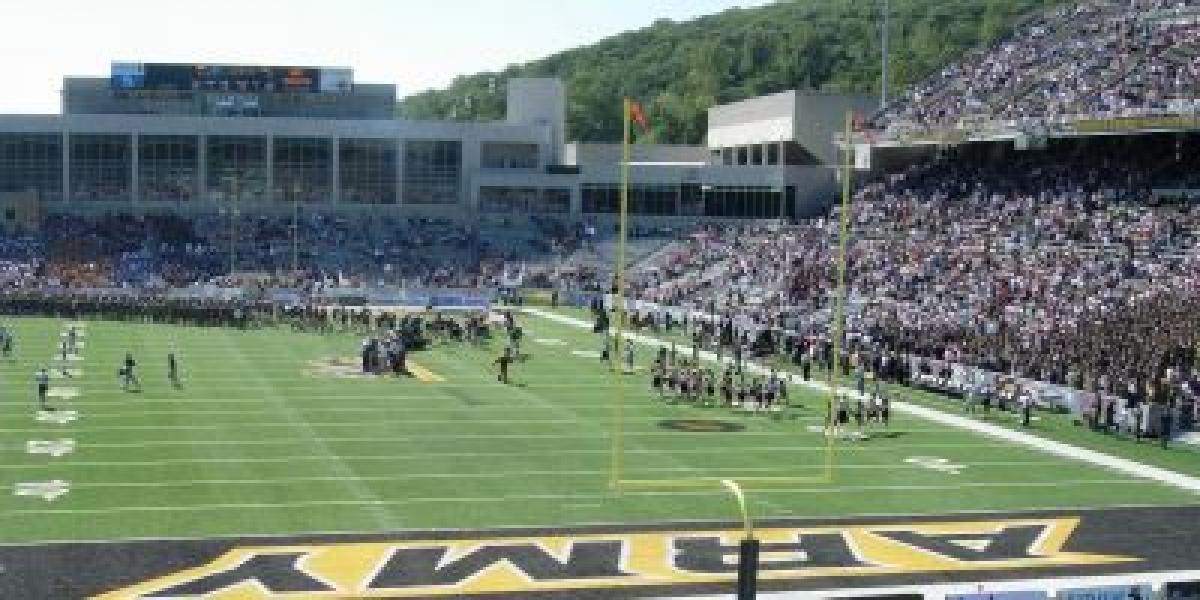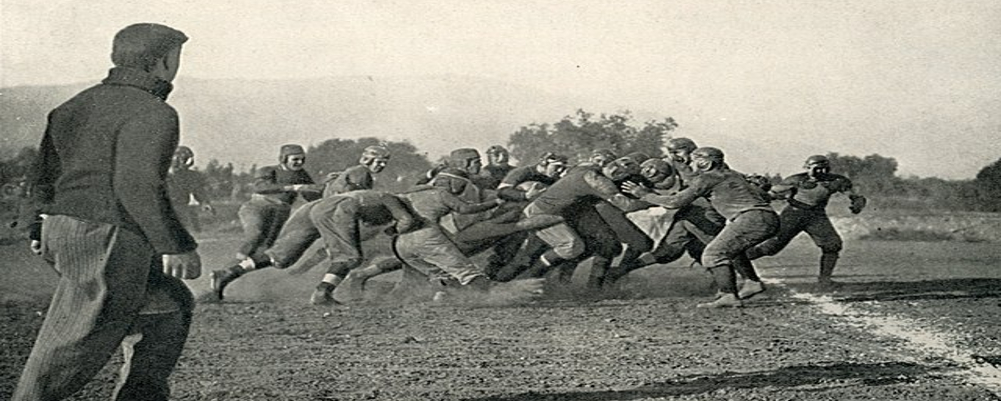Football Archaeologist Timothy Brown has done the research and shares with us the shape of the goal posts over the years.
Transcribed Conversation with Timothy Brown on Shape of Goal Post
Hello, my football friends; this is Darin Hayes of PigskinDispatch.com. Welcome once again to The Pig Pen, your portal for positive football history. And welcome to another entertaining episode where we go to go back in time of football antiquity with Timothy P. Brown of FootballArcheology.com. Tim, welcome back to The Pig Pen.
Hey, Darin. Good to see you. And hopefully, like a field goal attempt, this podcast will be all good. I hope so.
Let's keep it between the pipes and over the bar. So, Tim, I think that's a great segue because we're going to talk about one of your tidbits that you wrote recently on the shape of the goalpost pass. Now, that's really intriguing.
You can't think of too many different shapes for a goalpost, but you bring up some good points in your post that I'd love to hear about. Yeah, well, you know, actually, in the earliest days of football, they used goalposts that were rugby, like the rugby goals of the time, that were, you know, the same width as they are today. And the upright only stuck up about a foot above the crossbar.
So, early on, they really did have a little bit of a different shape. And, you know, in rugby, the ball was capable. And in soccer, it went under the crossbar.
But this tidbit was really not so much about the specifications as it was just the, you know, the kind of nature of especially smaller town teams and, you know, the early days when people just, you know, they kind of did the best they could in trying to construct, you know, some goalposts. And so, you know, I've written things like this in the past and, you know, show images, but, you know, some pictures of like, old, you know, little small town teams where nobody had, you know, they had shoulder pads, but they were homemade, you know, grandma made them or, you know, they're made out of like gingham or fabric and stuffed with who knows what, you know, corn husks or something, you know, or just cotton balls, you know, scraps, whatever it was, you know, homemade headgear. You know, a lot of times, the little teams would have this mishmash of uniforms, like they'd all try to wear something blueish or reddish, but that was as close as they got.
And then, you know, obviously, ill-fitting uniforms. I mean, even as a kid, we had those, it was like, you know, you go down your, you know, pants go down your ankles sometimes. So, anyway, the same thing happened with goalposts.
And so, you know, there were, well, I should also say, you know, on the fields, I've, you know, shown things in the past with crooked lines, yard lines that were chopped and they're crooked, or they're missing, they're only every 10 yards, foot high, you know, foot high grass, because they just didn't mow it. And then obviously muddy fields, collapsing bleachers. And, you know, really nasty-looking press boxes, just little shanties, are atop the top of the stadium.
So anyways, you know, not everything was as fancy as we have it today. So, that was the case with goalposts. And kind of over the years, you know, somewhere along the line, I'd noticed one or two, and it was like, okay, I got to collect up some of these and just kind of pay attention and look for them.
But so there are some instances, you know, that readers or listeners can click on the link and go see them. But, you know, there's somewhere, you know, the goalposts, at least the uprights, for sure, were made of timber, not even lumber. So, you know, there might have been a pine tree nearby, and they just chopped down the tree and, you know, lopped off the branches, and that became uprights.
And while it was generally straight, you know, might have a bend or two in there. There were other instances where it was milled lumber, but either when they installed it or by the time they took the picture, the uprights were no longer upright. You know, slanted in one form or another, you know, who knows, you know, freeze-thaw or something like that over a couple of seasons.
All of a sudden, it's over, you know, 70-degree angle, it's an 80-degree angle. There are other instances where, you know, it's pretty good. I mean, it looks like it's upright and, you know, square and everything, but it's just made of scrap lumber.
You know, you can tell it was like, somebody was, some maintenance department was told to go build one of these things. And, you know, I just used whatever scrap two-by-fours they had lying around to do it. So like, the crossbar would be made out of three or four two-by-fours, kind of nailed or screwed together.
Same thing with the uprights. And so, and then some of those would get a little jabberwocky, you know, over time. And then there's another one, the worst one; it's actually a Davidson College where the crossbar, you know, you know, like anybody who's bought two by fours, you know, you kind of try to line them up and make sure they're true, you know, they're straight.
But, you know, sometimes they're not, you know. It sort of reminds me of my neighbor's garage header, his 14-foot door sagging like that. So this one shows this, you know, it's, I think it's actually two pieces of wood, but one of them's badly warped.
So, you know, it's got a big bow in it. So, you know, at least, you know, kick out a better chance of making the field goal at this point than regulation would suggest. So, anyway, it's just one of those things that makes it kind of amusing to look at these images.
But, you know, it just kind of tells you that these guys wanted to play football, regardless, and they just, you know, whatever they had available, that's what they were going to work with, you know, stuff involved, you know, stuff on soccer balls or something, you know, with the rags or, you know, whatever, you do what you got to do. And so, and it's just, I mean, I just compared to, you know, like, I do a fair amount of driving around, or at least, have over my life and all up all over the country. And, you know, I see football fields, right?
And I pay, you know, I've always paid attention to them. And like, even in a dinky little town somewhere, their football fields, you know, they've got some central school or whatever, and they got a pretty nice football field, you know. And even the youth football fields, you know, look pretty good most of the time, you know, at least they're flat, you know, they're mowed.
They might have, you know, the goalposts might be, you know, H goalposts made out of, you know, just plumbing pipes or whatever, but it works, and it's straight, you know. So anyway, it's just that we all have it pretty good, at least as far as our goalposts are concerned nowadays. Yeah, I mean, this brings up so many memories of, you know, even my childhood.
These pictures are awesome. So folks, go to the link and take a look at these, you know, the very first one has sort of the trees that you're talking about as the uprights. And the one is, you know, it's fairly straight right at the crossbar, but it gets about four or five foot above it, it sort of bends in.
So I think if I'm coaching that kicker, hey, keep it just over the crossbar, that's your best chance. It's going to get worse as it goes up. But I can remember going out and playing like in the wintertime, you know, we were nuts.
We'd take like a frozen Nerf football and play out in the street, you know, with snow packed on the street. And we would try to set up our field on the street. So you had at each end, you could kick it over a wire, and we would tie, like, take somebody's old shoes and throw them up over the wire, and you had to kick it between those, but get it over the telephone wire or whatever, you know, so you just make, as you said, you make do with what you have and, you know, so you can play the game.
But yeah, these are brilliant, some of these things. And you got a couple of the images where the uprights are only maybe a couple of feet above the crossbar. So good luck if you're an official on that one. You had better have a good eye, especially a team like the one they worked for back then.
So, wow. So great stuff. You found some great images there, and you did great research.
So yeah. Yeah. So, you know, it was fun gathering those up and I just kind of had to wait till I had a critical mass before I could publish them.
Yeah. They said they're pretty, pretty great. But you have stuff like this all the time.
Each and every day, you have some, some great pieces of football from years past and yesteryear that you talk about and you educate people and I'm sure you educate yourself with it and you call them these tidbits. Maybe you could share with folks out there how they can enjoy your tidbits as well. Yeah.
So, you know, the best thing is just to go to footballarchaeology.com. You have to put in the www to get there and then so you can subscribe, and then you'll get an email with each day's tidbit. Alternatively, you can catch me on Twitter or threads where I'm football archaeology. And then, of course, you know, you can just go directly to the site, or you can read it.
If you have the Substack app, you can find me on Substack because that's where football archaeology is published. So those are your options. All right.
Well, Tim Brown, we really appreciate you educating us on how they built goalposts back in the day and how they played the game, you know, the way that the only way that they could. And we appreciate that. And we appreciate what you do each and every day.
Thank you. And we'll talk to you again next Tuesday. Very good.
See you next week.
Transcribed by TurboScribe.ai.



